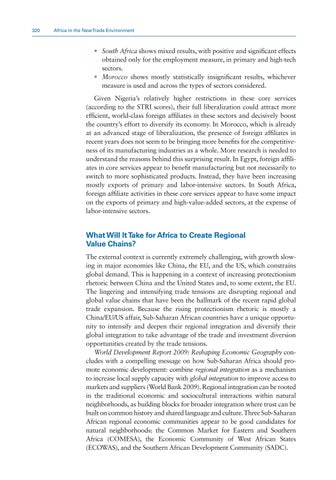320 Africa in the New Trade Environment
• South Africa shows mixed results, with positive and significant effects obtained only for the employment measure, in primary and high-tech sectors. • Morocco shows mostly statistically insignificant results, whichever measure is used and across the types of sectors considered. Given Nigeria’s relatively higher restrictions in these core services (according to the STRI scores), their full liberalization could attract more efficient, world-class foreign affiliates in these sectors and decisively boost the country’s effort to diversify its economy. In Morocco, which is already at an advanced stage of liberalization, the presence of foreign affiliates in recent years does not seem to be bringing more benefits for the competitiveness of its manufacturing industries as a whole. More research is needed to understand the reasons behind this surprising result. In Egypt, foreign affiliates in core services appear to benefit manufacturing but not necessarily to switch to more sophisticated products. Instead, they have been increasing mostly exports of primary and labor-intensive sectors. In South Africa, foreign affiliate activities in these core services appear to have some impact on the exports of primary and high-value-added sectors, at the expense of labor-intensive sectors.
What Will It Take for Africa to Create Regional Value Chains? The external context is currently extremely challenging, with growth slowing in major economies like China, the EU, and the US, which constrains global demand. This is happening in a context of increasing protectionism rhetoric between China and the United States and, to some extent, the EU. The lingering and intensifying trade tensions are disrupting regional and global value chains that have been the hallmark of the recent rapid global trade expansion. Because the rising protectionism rhetoric is mostly a China/EU/US affair, Sub-Saharan African countries have a unique opportunity to intensify and deepen their regional integration and diversify their global integration to take advantage of the trade and investment diversion opportunities created by the trade tensions. World Development Report 2009: Reshaping Economic Geography concludes with a compelling message on how Sub-Saharan Africa should promote economic development: combine regional integration as a mechanism to increase local supply capacity with global integration to improve access to markets and suppliers (World Bank 2009). Regional integration can be rooted in the traditional economic and sociocultural interactions within natural neighborhoods, as building blocks for broader integration where trust can be built on common history and shared language and culture. Three Sub-Saharan African regional economic communities appear to be good candidates for natural neighborhoods: the Common Market for Eastern and Southern Africa (COMESA), the Economic Community of West African States (ECOWAS), and the Southern African Development Community (SADC).


